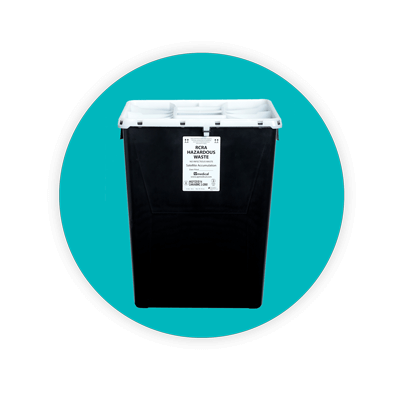Healthcare Waste Segregation

Daniels Health knows that all medical waste is not equal in how it should be disposed. Do you? Do you know the difference between chemotherapy waste, pharmaceutical waste, or pathological waste disposal management and guidelines that adhere to federal and state regulations?
Hazardous waste vs. Medical waste. What's the big deal? Each has their own specific set of regulations and guidelines on a federal and state level for how they should be disposed of. It is key for compliance to understand those specific guidelines for collection, containment, and disposal. Proper waste segregation is essential so that you maintain compliance and avoid massive fines and penalties, not to mention serious dings to your reputation.
Knowing how to segregate
Before you can segregate or separate waste, knowledge of different types of medical waste streams, or in other words, different types of medical waste, is vital. For example:
-
Biohazard waste must be contained in a red container or red liner inside a container. Several examples of biohazard waste include blood products, infectious waste, IV tubing, cultures, and contaminated personal protective equipment
-
Sharps - not just needles, but syringes, scalpels, trocars, staples, or any tool or implement with a sharp edge - must be placed in a sharps container. Sharps container placement is also important, as it reduces needlestick injury potential through the use of federal and state approved containers.
-
Non-RCRA Pharmaceutical waste includes antibiotics, pills, and injectable medications.
-
Resource Conservation and Recovery Act (RCRA) defines hazardous waste as including hazardous medications (expired (full) as well as partial doses)), pathological waste, and bulk chemo waste
-
Trace chemo waste is another waste stream that is defined as the remaining medications or used personal protective equipment that contains 3% or less by volume of the chemotherapeutic agent.
- Radioactive waste is another waste stream and may contain components such as iodine-131, cobalt-60, and iridium-192, among others.
Proper identification and characterization of healthcare waste is important for compliant waste stream segregation. For example, it is against regulations to mix anything potentially contaminated with blood or other bodily fluids with general “solid waste” that may be found in a patient’s or facility’s “regular” waste cans.
Waste segregation is vital in protecting not only medical and healthcare employees, but the public. Accurately categorizing your healthcare waste helps prevent spread of infectious diseases. Proper waste segregation also helps keep our environment as clean as possible and reduces the volume of medical waste that ends up in landfills. Daniels Health is experienced in guiding waste generators with accurate and effective waste segregation methods that meet federal and state governmental guidelines, most specifically those specified by the Resource Conservation and Recovery Act.
Following RCRA guidelines
RCRA provides thorough information and regulations regarding segregation, handling, containment, storage, and transportation as well as disposal of hazardous and non-hazardous waste. Regulations pertinent to hazardous waste are found under title 40 CFR, Parts 260 through 273. For example:
- Part 261 identifies and lists types of hazardous waste
- Part 262 specifies applicable standards to generators of hazardous waste
- Part 263 provides information for and applicable standards to those who transport hazardous waste
Daniels Health is aware of the specificity of Title 40 as it applies to protection of the environment found under the Code of Federal Regulations. For example § 262.11 - hazardous waste determination, provides guidelines as to how a waste generator can determine if the waste is hazardous or not. Generators must follow a specific methodology that determines whether that waste is excluded, whether it’s listed as a hazardous waste, and so forth.
Civil penalties for RCRA violations can be up to $70,117 per violation per day. Those are the fines stipulated by the Environmental Protection Agency. On top of that, state agencies can also mandate fines, penalties, and even jail time for non-compliance.
Improper waste segregation leads to improper disposal. Improper disposal increases the risks of exposure to communicable illnesses such as hepatitis, HIV, and AIDS, among others. Don’t put your employees or facility at risk - segregate!
Reducing risk of improper waste segregation
Properly managed and labeled containers are an effective way to ensure proper, safe and compliant waste segregation for healthcare waste generators. Teaching employees in proper waste segregation methods is essential. Can you put a used needle into a bag, as long as it’s a red biohazard bag? Daniels Health can answer that question for you. For some healthcare wastes; such as medical waste or hazardous waste, proper training is required for staff who handles, packages, marks or labels the waste.
It’s also important to understand that regular trash must be segregated from any type of medical waste. We want to reduce the risk of a needlestick injury. Federally and state approved sharps container methods and sharps container placement is important as well.
Instructing employees or any entity to that handles healthcare waste should handle such containers correctly. Non-compliance can promote spillage, leaks, or ruptures in containers. Incorrect usage of colored bags or containers, coupled with lack of information on visible and properly placed labels, is also a violation for non-compliance waiting to happen. Failure to categorize waste streams is one of the most common compliance errors when it comes to medical waste disposal.
When it comes to your healthcare waste removal or disposal, compliance is key. It is a generator’s responsibility to manage healthcare waste from “cradle-to-grave” and properly document this process. Daniels Health is here to help guide you through the often confusing mass of federal and state regulations when it comes to waste segregation, waste stream management, and healthcare waste management methodologies.
